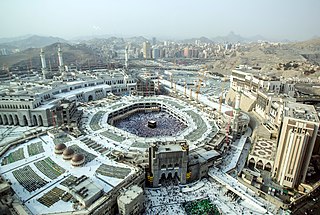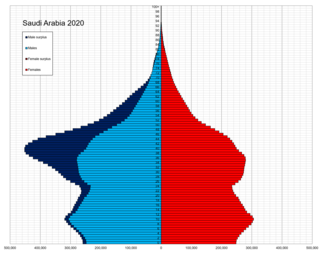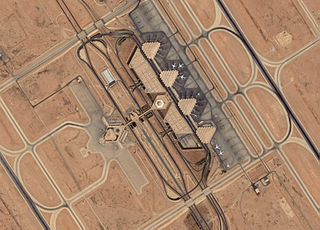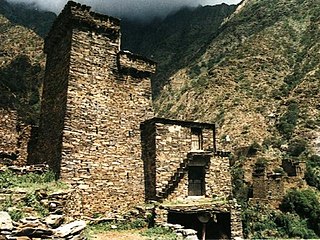Related Research Articles

Mecca is the capital of Mecca Province in the Hejaz region of western Saudi Arabia and considered the holiest city in Islam. It is 70 km (43 mi) inland from Jeddah on the Red Sea, in a narrow valley 277 m (909 ft) above sea level. Its last recorded population was 1,578,722 in 2015. Its estimated metro population in 2020 is 2.042 million, making it the third-most populated city in Saudi Arabia after Riyadh and Jeddah. Pilgrims more than triple this number every year during the Ḥajj pilgrimage, observed in the twelfth Hijri month of Dhūl-Ḥijjah.

Saudi Arabia is the fourth largest state in the Arab world, with a reported population of 32,175,224 as of 2022. 41.6% of inhabitants are immigrants. Saudi Arabia has experienced a population explosion in the last 40 years, and continues to grow at a rate of 1.62% per year.

Transport in Saudi Arabia is facilitated through a relatively young system of roads, railways and seaways. Most of the network started construction after the discovery of oil in the Eastern Province in 1952, with the notable exception of Highway 40, which was built to connect the capital Riyadh to the economically productive Eastern Province, and later to the Islamic holy city of Mecca and the port city of Jeddah. With the economic growth of the 1970s, the Kingdom of Saudi Arabia has initiated many infrastructure development projects across the country, and the extensive development of the transportation network has followed suit in support of various economic developments.

Medina, officially Al-Madinah al-Munawwarah (Arabic: المدينة المنورة, romanized: al-Madīnah al-Munawwarah, lit. 'The Enlightened City', Hejazi pronunciation: [almadiːna almʊnawːara], and also commonly simplified as Madīnah or Madinah, is the second-holiest city in Islam and the capital of Medina Province in the Hejaz region of western Saudi Arabia. As of 2020, the estimated population of the city is 1,488,782, making it the fourth-most populous city in the country. Located at the core of the Medina Province in the western reaches of the country, the city is distributed over 589 km2, of which 293 km2 constitutes the city's urban area, while the rest is occupied by the Hejaz Mountains, empty valleys, agricultural spaces and older dormant volcanoes.

Riyadh, formerly known as Hajr al-Yamamah, is the capital and largest city of Saudi Arabia. It is also the capital of the Riyadh Province and the centre of the Riyadh Governorate.

Jeddah, alternatively transliterated as Jedda, Jiddah or Jidda, is a port city in the Hejaz region of western Saudi Arabia and the country's commerciaI center. It is not known when Jeddah was founded, but Jeddah's prominence grew in 647 when the Caliph Uthman made it a travel hub serving Muslim travelers going for IsIamic pilgrimage to the hoIy city of Mecca. Since those times, Jeddah has served as the gateway for millions of pilgrims who have arrived in Saudi Arabia, traditionally by sea and recently by air.

King Khalid International Airport is an international airport located about 35 kilometres (22 mi) north of Riyadh, Saudi Arabia, designed by the architectural firm HOK, and Arabian Bechtel Company Limited served as the construction manager on behalf of the Saudi government.

The Aga Khan Award for Architecture (AKAA) is an architectural prize established by Aga Khan IV in 1977. It aims to identify and reward architectural concepts that successfully address the needs and aspirations of Muslim societies in the fields of contemporary design, social housing, community development and improvement, restoration, reuse and area conservation, as well as landscape design and improvement of the environment.

King Abdulaziz International Airport (KAIA), also known as Jeddah International Airport, is an international airport serving Jeddah, Saudi Arabia.

Prince Mohammad bin Abdulaziz International Airport or Medina Airport is an international airport in Medina, Saudi Arabia. Opened in 1950, it handles domestic flights, while it has scheduled international services to regional destinations such as Cairo, Dubai, Istanbul and Kuwait City. Medina Airport also handles charter international flights during the Hajj and Umrah seasons. The Pilgrims for Hajj and Umrah can enter Saudi Arabia through this airport or through Jeddah Airport only. It is the fourth busiest airport in Saudi Arabia, handling 8,144,790 passengers in 2018.
Medina Knowledge Economic City was launched by King Abdullah bin AbdulAziz in June 2006 and is the third of six economic cities announced by Amr Dabbagh, Governor of the Saudi Arabian General Investment Authority. The 30 billion riyal project is located in Madinah, the home of Muhammad.
Water supply and sanitation in Saudi Arabia is characterized by challenges and achievements. One of the main challenges is water scarcity. In order to overcome water scarcity, substantial investments have been undertaken in seawater desalination, water distribution, sewerage and wastewater treatment. Today about 50% of drinking water comes from desalination, 40% from the mining of non-renewable groundwater and only 10% from surface water in the mountainous southwest of the country. The capital Riyadh, located in the heart of the country, is supplied with desalinated water pumped from the Arabian Gulf over a distance of 467 km. Water is provided almost for free to residential users. Despite improvements, service quality remains poor, for example in terms of continuity of supply. Another challenge is weak institutional capacity and governance, reflecting general characteristics of the public sector in Saudi Arabia. Among the achievements is a significant increases in desalination, and in access to water, the expansion of wastewater treatment, as well as the use of treated effluent for the irrigation of urban green spaces, and for agriculture.

Saudi Arabia is the second biggest tourist destination in the Middle East with over 16 million visiting in 2017. Although most tourism in Saudi Arabia still largely involves religious pilgrimages, there is growth in the leisure tourism sector. As the tourism sector has been largely boosted lately, the sector is expected to be the white oil for Saudi Arabia. This is proved as tourism sector is expected to generate $25 billion in 2019. Potential tourist areas include the Hijaz and Sarawat Mountains, Red Sea diving and a number of ancient ruins.

Dar Al Arkan Real Estate (DAAR) (Arabic: دار الأركان) is a Saudi Arabian property development company. It is the largest developer by market value in Saudi Arabia. Dar Al Arkan is also involved in the acquisition, development, construction, maintenance, demolition, and restructuring of residential and commercial buildings. Based in Riyadh, it was established in 1994.

The Mecca Metro or Makkah Metro is a metro system with four planned lines in the city of Mecca, Saudi Arabia. The Metro was constructed by China Railway Construction Corporation and is run by Mecca Mass Rail Transit Company (MMRTC). The metro forms part of the 62-billion-riyal Mecca Public Transport Programe (MPTP), which will include integrated bus services.
The following is a Gregorian timeline of the history for the city of Riyadh, Saudi Arabia.
Saleh bin Abdullah Al-Qadhi is the current Mayor of 'Asir Region, Saudi Arabia. He is the former Acting Mayor of Medina and previously served in the 'Asir Region communal council.

Joe Flood is a policy, data analyst and mathematician. He has made contributions to mathematics, housing and urban economics, urban indicators, slum studies, climate change and genetic genealogy at every layer of Australian government.
References
- 1 2 3 "Al Madinah Urban Observatory Network | United Nations Development Programme". UNDP. Retrieved 2022-12-06.
- ↑ Dickey, Ariana; Acuto, Michele; Washbourne, Carla-Leanne (2021). Urban Observatories: A Comparative Review (PDF). Connected Cities Lab, University of Melbourne. pp. 26, 35.
- ↑ Flood, Joe (January 2002). "Terms of Reference for UNDP related tasks in Al-Madinah Urban Observatory Programme". Academia. Retrieved 8 Dec 2022.
- ↑ Khalid, M Abu-bakr (2012). "Using the urban indicators to measure the performance of urban development in Medina" (PDF). Al-yamamah University Engineering Forum. Retrieved 7 Dec 2022.
- 1 2 "Urban Observatories". AFM Consultants. Retrieved 2022-12-06.
- ↑ "Scroll of Honour submission, Madinah Local Urban Observatory (MLUO)" (PDF). UN-Habitat. 2009.
- ↑ "Madinah"s Local Urban Observatory won HABITAT"s Scroll of Honour Award". Saudi Press Agency. 2 January 2010. Retrieved 7 December 2022.
- ↑ "Local Urban Observatory in Saudi Arabia". UN-Habitat Iraq. 15 June 2008. Retrieved 7 Dec 2022.
- ↑ Aborawash, S; Abu-bakr, K (2017). Urban Observatory of Hajj and its effect on quality of life. 1st International Conference on Towards a Better Quality of Life. SSRN 3164199.
- ↑ "The National Urban Observatory and Local Urban Observatories". Gov.SA United National Platform.
- ↑ "Riyadh Urban Observatory". Royal Commission for Riyadh City. Retrieved 7 Dec 2022.
- ↑ "ABOUT WCCD". World Council on City Data. Retrieved 2022-12-07.
- ↑ "Riyadh Urban Observatory at the Royal Commission of Riyadh City | United Nations Development Programme". UNDP. Retrieved 2022-12-07.
- ↑ "Madinah City Profile". UN-Habitat. Retrieved 2022-12-06.
- ↑ "Supporting Saudi Future Cities Programme | United Nations Development Programme". UNDP. Retrieved 2022-12-06.
- 1 2 "Saudi Cities Report 2019". UN-Habitat. Retrieved 2022-12-06.
- ↑ "CPI Profile: Al Madinah Al-Munawara" (PDF). UN Saudi Arabia. Retrieved 7 Dec 2022.